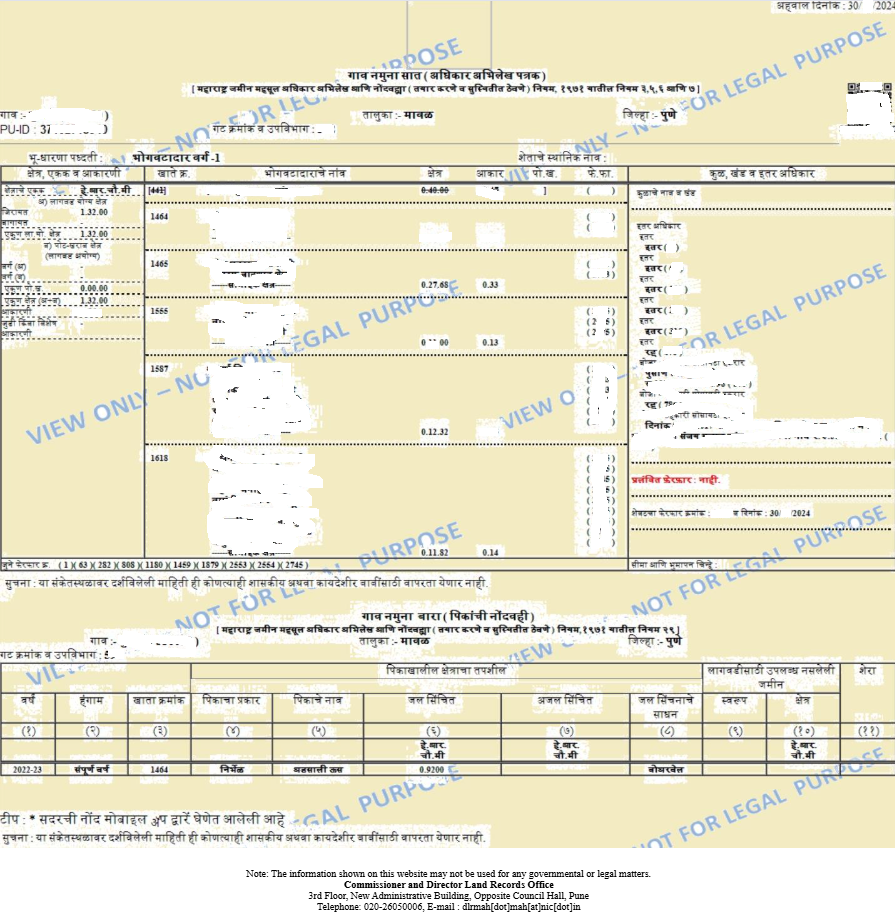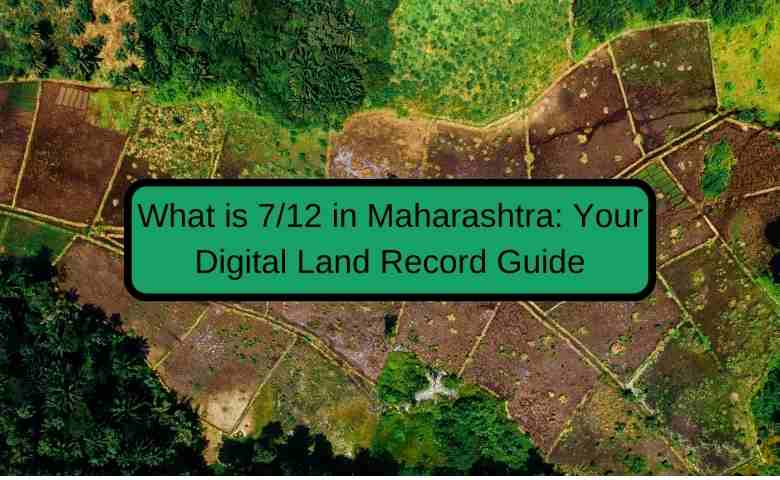Last Updated on March 24, 2025 by Admin
Maharashtra’s 7/12 extract, often referred to as the Satbara Utara, is a cornerstone document in the state’s real estate and agricultural sectors. It offers detailed information on land ownership, area, crop details, and any liabilities attached to the property. Whether you are a prospective buyer, a farmer, or a legal professional, understanding this document is essential for verifying property details and ensuring a transparent transaction process.
In this guide, we cover everything—from the history and measurement systems to the digital platforms that make obtaining and updating the 7/12 extract simpler.
Table of Contents
The Significance of the 7/12 Extract
The 7/12 extract is not just a record of land ownership; it serves multiple functions:
- Proof of Ownership: Confirms the legal owner(s) of the land.
- Land Details: Lists the survey number, area, and classification of land.
- Agricultural Information: Documents crop types, cultivation details, and irrigation status.
- Financial Liabilities: Records any encumbrances, mortgages, or pending dues.
- Legal Evidence: Essential for property transactions, loan approvals, and dispute resolution.
With increasing cases of fraud and disputes in real estate, a complete and updated 7/12 extract is more crucial than ever. Also, kindly this guide to Types of Plots and Housing in India
The Evolution to Digital: From Guntha to Metric Units
Historically, traditional units like Guntha were used in Maharashtra’s land records. However, since the early 1970s—when India adopted the metric system—land measurements in the 7/12 extract have been standardized into:
- Hectares (हे): 1 hectare = 10,000 sq. meters.
- Ares (आर): 1 are = 100 sq. meters (or 1076.4 sq. ft).
- Square Meters (चौरस मीटर): The base unit of area.
It is important to note that while Guntha (1089 sq. ft) was once common, the 7/12 extract now exclusively uses metric units. This shift has reduced confusion and brought precision to property measurements.

Breaking Down the 7/12 Extract
The document consists mainly of two forms:
Form VII:
- Owner Details: Name(s) of the owner(s), rights, and share in the property.
- Survey and Boundaries: Survey number, village, and other geographical identifiers.
Form XII:
- Agricultural Information: Types of crops, irrigation details, and land suitability.
- Land Use and Liabilities: Information regarding taxes, loans, or any legal disputes.
Understanding these sections ensures that you can verify the authenticity of the land record and identify any potential issues before a transaction.
For a detailed explanation on reading the 7/12 extract, visit HomeBazar’s simple guide
How to Access 7/12 Extracts Digitally
Official Portals
The Maharashtra government has modernized land record access through several digital platforms:
1. Mahabhulekh Portal:
An official state website where you can search, view, and download your 7/12 extract by entering your district, taluka, village, and survey number. The system now supports both viewing and downloading digitally signed copies. Visit the Mahabhulekh portal for up-to-date information.
2. Aaple Sarkar:
This portal is used for online applications including updating or mutating the 7/12 extract (e.g., adding or correcting an owner’s name).
Steps to Download Your 7/12 Extract Online
- Visit the Official Website: Navigate to the Mahabhulekh or Aaple Sarkar portal.
- Select Your Region: Choose your district, taluka, and village from the dropdown menus.
- Enter Property Details: Input the survey number or owner’s name to locate your land record.
- View and Download: Once your record is displayed, you can view it online or download a digitally signed copy.
- Fee Payment: A nominal fee (usually around Rs 15) is deducted from your account for the digital copy, valid for a specified download period.
Sample 7/12 Extract
Here is the sample 7/12 extract downloaded from the Mahabhulekh website.

Latest Updates and Digital Advancements
As of March 2025, several initiatives have further streamlined the process of managing and updating land records in Maharashtra:
- Enhanced Online Accessibility: New user-friendly interfaces on portals like Mahabhulekh and Aaple Sarkar make searching and updating records easier than ever.
- Instant Downloads: Platforms such as Landeed now allow for near-instant access to both new and historical 7/12 and mutation records, ensuring complete transparency in land transactions.
Read more about these digital advancements on Landeed’s platform - Government Reforms: Recent amendments in the land revenue system have further reduced processing times and fees, benefiting both rural and urban property owners.
These changes underscore Maharashtra’s commitment to leveraging technology for better governance and enhanced service delivery in land record management.
Land records departments of the top 10 States of India
As of March 2025, here is an updated list of land records departments and their official websites for ten prominent states in India, organized alphabetically:
| State | Land Records Department Name | Official Website |
|---|---|---|
| Andhra Pradesh | Meebhoomi | https://meebhoomi.ap.gov.in/ |
| Gujarat | AnyRoR | https://anyror.gujarat.gov.in/ |
| Haryana | Jamabandi | https://jamabandi.nic.in/ |
| Jharkhand | Jharbhoomi | https://jharbhoomi.nic.in/ |
| Karnataka | Bhoomi | https://www.landrecords.karnataka.gov.in/ |
| Maharashtra | Mahabhumi (Bhumi Abhilekh) | https://bhulekh.mahabhumi.gov.in/ |
| Punjab | Punjab Land Record Society | https://plrs.org.in/ |
| Rajasthan | Apna Khata/E-Dharti | https://apnakhata.raj.nic.in/ |
| Tamil Nadu | Patta Chitta | https://eservices.tn.gov.in/eservicesnew/ |
| Uttar Pradesh | Bhulekh Uttar Pradesh | https://upbhulekh.gov.in/ |
These online portals have been developed under the Digital India Land Records Modernization Programme (DILRMP) to digitize and modernize land records, enhancing transparency and accessibility across the country.
Conclusion
The 7/12 extract is a vital document that provides a detailed record of land ownership and agricultural details in Maharashtra. With the adoption of digital platforms like Mahabhulekh, and Aaple Sarkar accessing and updating these records has become faster, more accurate, and highly convenient.
Whether you are verifying property ownership, applying for a loan, or resolving legal disputes, having a clear understanding of your 7/12 extract and how to manage it online is essential. Stay informed with the latest tools and resources to navigate Maharashtra’s real estate landscape confidently.
Embrace the digital era and ensure your land records are accurate and up-to-date for a hassle-free property transaction experience.
This guide is updated as of March 2025. Always check with official portals and trusted sources for the most current information.
Related Posts:
- How to Enhance Documentation in Construction Management
- Unlocking the Real Estate Puzzle: A Comprehensive Guide to Types of Plots and Housing in India
- Finding Your Piece of the Earth: A Comprehensive Guide to Buying Land
- Land Surveyor Job Description and Salary Details
Frequently Asked Questions
The 7/12 Extract is an essential land record document in Maharashtra, India. It provides detailed information about a land parcel’s ownership, agricultural details, and history. This document is crucial for verifying property ownership, ensuring legal transactions, and performing agricultural assessments.
The measurement system in the 7/12 Extract has transitioned from traditional units such as Guntha to metric units including hectares, ares, and square meters. This change ensures greater accuracy and standardization in land measurement and record-keeping.
To update your 7/12 record, such as adding a new name due to ownership change, you can apply for mutations through Maharashtra’s Aaple Sarkar portal. This process requires the submission of necessary legal documents and a fee, followed by verification by the local revenue office to reflect the changes officially.
What is the difference between a 7/12 extract and a Property Card?
While the 7/12 extract is utilized for rural and agricultural land records, the Property Card, or Malmatta Patrak, is used for urban properties. Each serves specific administrative purposes in managing property records and transactions in different geographical settings.


